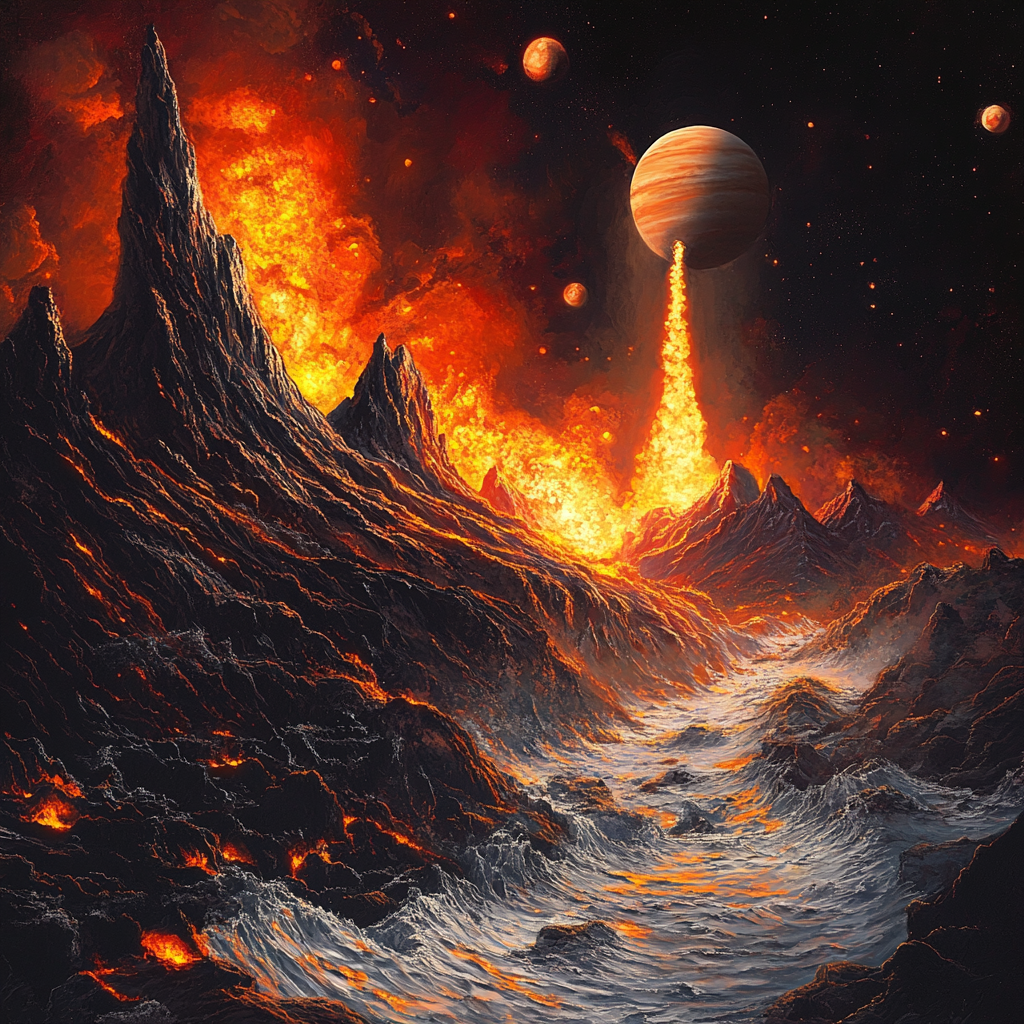
Jupiter’s Moon Io: Unraveling the Mystery Behind Its Volcanic Eruptions
In the vast realm of celestial wonders floating in the infinite black void, there lies a tiny, tempestuous world that would make even the most stoic geologist blush with envy. Welcome to Io, the volcanic darling of Jupiter. This moon, with its delightful drama and fiery temper, doesn’t just recycle the usual baked rock and ice that you might expect from a celestial body. No, Io is a cosmic cauldron, boiling with over 400 known volcanoes – a staggering number when you consider that Earth has only around 1,500 active volcanoes! So, what’s at the heart of Io's broiling madness? It's time to leap into this fiery pot of extraterrestrial intrigue and see what makes this moon tick.
Let’s start with the titanic heavyweight in this celestial soap opera: tidal heating. Imagine for a moment, Io's peculiar ballet around its gigantic overlord, Jupiter. This moon dances in a complex gravitational tango with its bigger buddies, Europa and Ganymede, thanks to a delightful little arrangement called Laplace resonance. As Io pirouettes closer to Jupiter, the enormous gravitational clutches of the giant planet stretch and squeeze this unyielding rock, causing it to flex and bend like a rubber band pulled to its limit. This is no ordinary grip; it’s the kind that releases colossal amounts of heat, literally cooking the innards of Io and turning solid rock into bubbling magma.
Tidal heating is the life-giving force behind Io's volcanic frenzy, and it’s a striking contrast to our own Earth. Sure, Earth has its share of volcanoes, but these are mainly powered by the internal heat generated from the decay of radioactive isotopes and ancient heat left over from its formation. Io, however, doesn’t get cozy with internal engines. No, it prefers the external flair that comes with being Jupiter's moon. When the volcanic forces hit, gray plumes and bright yellow sulfur fills the sky, spewing mixtures of gas and molten rock high into space—a fiery volcano’s alluring fount spilling over.
But wait! Let’s not jump the gun here. The conversation about Io can’t just stop at tidal heating. A burning question that has tantalized the minds of planetary scientists for years is whether this tempestuous moon is sitting on a grand magma ocean, which would give it a complex underground world similar to what scientists speculate existed on the early moon of Earth. Recent data from NASA’s Juno spacecraft, however, throw a wrench into this doctrine. The close flybys that took place in 2023 and 2024 unveiled a treasure trove of gravity data, suggesting that Io could very well have a mostly solid interior. The magma isn’t globs of molten rock flowing freely beneath the surface but rather individual volcanic chambers—each with its own bubbling pot of lava—reminiscent of a blossoming volcano with its unique character.
This revelation sends ripples not just through the community of scientists studying Io but throughout the grand narrative of planetary evolution. The conclusion could hint at a broader implication for moons and exoplanets dancing closely around their parent stars. It opens doors to how we perceive the potential geological activity lurking in the shadows of celestial bodies, like Europa’s watery environment or Enceladus's icy surface. It’s all a complex web of gravitational forces, tidal heating, and volcanic whimsy.
Now, if you’ve been so mesmerized by the volcanic outbursts and flickering magma flows, let’s turn our attention to the faithful observers of Io’s captivating story: the Io Input/Output observatory, affectionately known as IoIO, and NASA's Juno spacecraft. These instruments have turned into the eyes and ears sending back stunning visuals and data chronicling Io's insatiable appetite for eruptions. They witnessed a massive volcanic event in 2022 that not only erupted lava but shimmered in sodium – a gas that glows fantastically bright when excited by Jovian energy.
As for the types of eruptions, Io keeps its volcanic personality quite dynamic. Scientists have identified a trio of eruption types distinguished by their eruption patterns and where they take place. Among them, the Pele-type plume stands out, conjuring images of amber lava fireworks shooting up to 500 kilometers in the sky. These plumes, formed from sulfur and sulfur dioxide gases bubbling and bursting out from the magma, are not just a sight for sore eyes but are harbingers of Io's volcanic identity, showcasing the complexity beneath its colorful and contrasting surface.
So here we are—not just scratching the surface, but diving into the hot depths of Io's turbulent existence. This moon is a dazzling showcase of cosmic calamity, a delicate balance between gravitational might and geological ferocity. While tidal heating remains an accepted force behind its volcanic activities, the winding road of discovery continues to intrigue scientists who grapple with the layered complexities of Io’s interior structure.
As we peel back the layers of this extraterrestrial Jordan, we confront inevitable questions regarding the fundamental nature of planetary development and are amazed by the constant evolution of our understanding. Every new revelation adds to our comprehension of these celestial wonders, each eruption is a note in the symphony of space, echoing tales of chaos and creation.
So hang on to your telescopes and pack your bags—Io holds a universe of secrets just waiting to be uncovered. If you're as enthralled by the rhythmic eruptions of this distant moon as by a sumptuous cup of tea, then perhaps Io deserves a spot on your cosmic travel list.
And if you're eager to keep your finger on the pulse of the galaxy’s latest shenanigans, remember: the universe is always whispering fresh tidbits of knowledge waiting to be revealed. Want to stay up to date with the latest news on neural networks and automation? Subscribe to our Telegram channel: @channel_neirotoken.
Keep exploring, keep questioning, and above all, keep your mind open to the infinite possibilities that the universe presents us!

